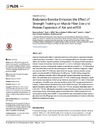Please use this identifier to cite or link to this item:
https://accedacris.ulpgc.es/jspui/handle/10553/52609
| Title: | Endurance exercise enhances the effect of strength training on muscle fiber size and protein expression of akt and mTOR | Authors: | Kazior, Zuzanna Willis, Sarah J. Moberg, Marcus Apró, William Calbet, Jose A. L. Holmberg, Hans-Christer Blomstrand, Eva |
UNESCO Clasification: | 241106 Fisiología del ejercicio | Keywords: | Human Skeletal-Muscle Resistance Exercise Messenger-Rna Adenosine Triphosphatase Contractile Activity, et al |
Issue Date: | 2016 | Journal: | PLoS ONE | Abstract: | Reports concerning the effect of endurance exercise on the anabolic response to strength training have been contradictory. This study re-investigated this issue, focusing on training effects on indicators of protein synthesis and degradation. Two groups of male subjects performed 7 weeks of resistance exercise alone (R; n = 7) or in combination with preceding endurance exercise, including both continuous and interval cycling (ER; n = 9). Muscle biopsies were taken before and after the training period. Similar increases in leg-press 1 repetition maximum (30%; P<0.05) were observed in both groups, whereas maximal oxygen uptake was elevated (8%; P<0.05) only in the ER group. The ER training enlarged the areas of both type I and type II fibers, whereas the R protocol increased only the type II fibers. The mean fiber area increased by 28% (P<0.05) in the ER group, whereas no significant increase was observed in the R group. Moreover, expression of Akt and mTOR protein was enhanced in the ER group, whereas only the level of mTOR was elevated following R training. Training-induced alterations in the levels of both Akt and mTOR protein were correlated to changes in type I fiber area (r = 0.55-0.61, P<0.05), as well as mean fiber area (r = 0.55-0.61, P<0.05), reflecting the important role played by these proteins in connection with muscle hypertrophy. Both training regimes reduced the level of MAFbx protein (P<0.05) and tended to elevate that of MuRF-1. The present findings indicate that the larger hypertrophy observed in the ER group is due more to pronounced stimulation of anabolic rather than inhibition of catabolic processes. | URI: | https://accedacris.ulpgc.es/handle/10553/52609 | ISSN: | 1932-6203 | DOI: | 10.1371/journal.pone.0149082 | Source: | PLoS ONE [EISSN 1932-6203], v. 11 (2), (Febrero 2016) |
| Appears in Collections: | Artículos |
SCOPUSTM
Citations
60
checked on Jun 8, 2025
WEB OF SCIENCETM
Citations
54
checked on Jun 8, 2025
Page view(s)
147
checked on Dec 7, 2024
Download(s)
101
checked on Dec 7, 2024
Google ScholarTM
Check
Altmetric
Share
Export metadata
Items in accedaCRIS are protected by copyright, with all rights reserved, unless otherwise indicated.
